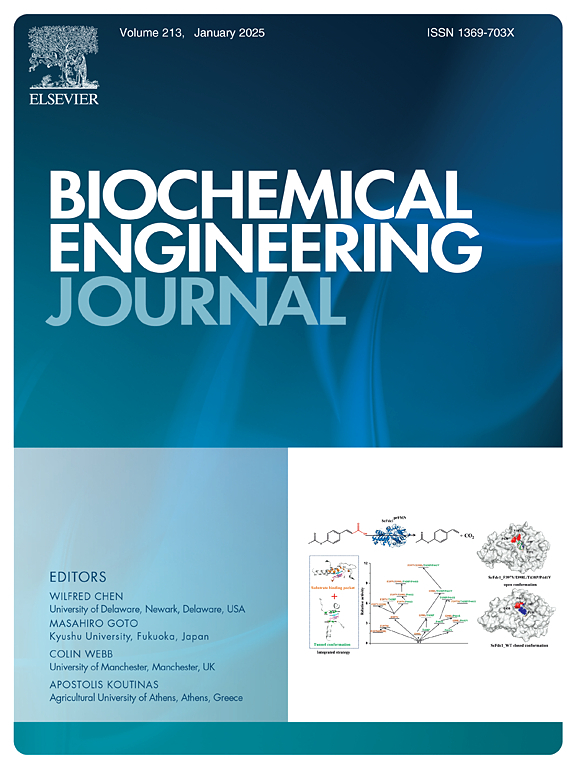Assessment of in situ product recovery techniques to enhance 2-phenylethanol production by Acinetobacter soli ANG344B
IF 3.7
3区 生物学
Q2 BIOTECHNOLOGY & APPLIED MICROBIOLOGY
引用次数: 0
Abstract
The 2-phenylethanol (2-PE) production process by the newly isolated Acinetobacter soli ANG344B is limited by product toxicity. To overcome this limitation and enhance 2-PE production process, various alternatives based in in situ product removal (ISPR) approaches were evaluated. The approaches selected for assessment were gas stripping using the air supplied to the bioreactor, liquid-liquid extraction and adsorption. Adsorption was found to be the most promising approach to increase 2-PE production. Amberlite XAD 4 was chosen from the different adsorbents tested since it has high affinity for 2-PE, being able to adsorb 205.8 ± 8.1 mg2-PE/gdry resin. In a batch cultivation process, in presence of 3 % (dry w/v) of Amberlite XAD 4, A. soli ANG344B was able to produce 6.99 ± 0.06 g/L of 2-PE with a volumetric productivity of 0.17 ± 0.00 g/L.h, which represents an improvement of 3.3-fold. To the best of our knowledge, this is the highest 2-PE production reported for a wild-type bacteria. These findings highlight the potential of Acinetobacter soli ANG344B as 2-PE producer, contributing to the development of natural 2-PE production process.
评估原位产品回收技术,以提高固氮醋酸杆菌 ANG344B 的 2-苯基乙醇产量
新分离出的固态醋酸乙烯杆菌(Acinetobacter soli ANG344B)生产 2-苯基乙醇(2-PE)的过程受到了产物毒性的限制。为了克服这一局限性并改进 2-PE 生产工艺,我们评估了基于原位产物去除(ISPR)方法的各种替代品。选定用于评估的方法包括利用提供给生物反应器的空气进行气提、液液萃取和吸附。吸附法被认为是最有希望提高 2-PE 产量的方法。从测试的不同吸附剂中选择了 Amberlite XAD 4,因为它对 2-PE 有很高的亲和力,能够吸附 205.8 ± 8.1 mg2-PE/gdry 树脂。在批量培养过程中,在含有 3 %(干重/体积)Amberlite XAD 4 的情况下,A. soli ANG344B 能够生产 6.99 ± 0.06 g/L 的 2-PE,体积生产率为 0.17 ± 0.00 g/L.h,提高了 3.3 倍。据我们所知,这是野生型细菌的最高 2-PE 产量。这些发现凸显了单歧杆菌 ANG344B 作为 2-PE 生产者的潜力,有助于天然 2-PE 生产工艺的发展。
本文章由计算机程序翻译,如有差异,请以英文原文为准。
求助全文
约1分钟内获得全文
求助全文
来源期刊

Biochemical Engineering Journal
工程技术-工程:化工
CiteScore
7.10
自引率
5.10%
发文量
380
审稿时长
34 days
期刊介绍:
The Biochemical Engineering Journal aims to promote progress in the crucial chemical engineering aspects of the development of biological processes associated with everything from raw materials preparation to product recovery relevant to industries as diverse as medical/healthcare, industrial biotechnology, and environmental biotechnology.
The Journal welcomes full length original research papers, short communications, and review papers* in the following research fields:
Biocatalysis (enzyme or microbial) and biotransformations, including immobilized biocatalyst preparation and kinetics
Biosensors and Biodevices including biofabrication and novel fuel cell development
Bioseparations including scale-up and protein refolding/renaturation
Environmental Bioengineering including bioconversion, bioremediation, and microbial fuel cells
Bioreactor Systems including characterization, optimization and scale-up
Bioresources and Biorefinery Engineering including biomass conversion, biofuels, bioenergy, and optimization
Industrial Biotechnology including specialty chemicals, platform chemicals and neutraceuticals
Biomaterials and Tissue Engineering including bioartificial organs, cell encapsulation, and controlled release
Cell Culture Engineering (plant, animal or insect cells) including viral vectors, monoclonal antibodies, recombinant proteins, vaccines, and secondary metabolites
Cell Therapies and Stem Cells including pluripotent, mesenchymal and hematopoietic stem cells; immunotherapies; tissue-specific differentiation; and cryopreservation
Metabolic Engineering, Systems and Synthetic Biology including OMICS, bioinformatics, in silico biology, and metabolic flux analysis
Protein Engineering including enzyme engineering and directed evolution.
 求助内容:
求助内容: 应助结果提醒方式:
应助结果提醒方式:


